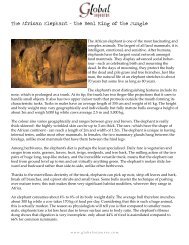The San People: Africa's Ultimate Survivors - Global Sojourns
The San People: Africa's Ultimate Survivors - Global Sojourns
The San People: Africa's Ultimate Survivors - Global Sojourns
Create successful ePaper yourself
Turn your PDF publications into a flip-book with our unique Google optimized e-Paper software.
<strong>The</strong> <strong>San</strong> are a light skinned folk, whose distinct yellow-brown skin wrinkles prematurely. <strong>The</strong>y havea<br />
body structure slightly smaller than that of the average person. <strong>The</strong>y appear to have bulging foreheads,<br />
ears without lobes, and have taut tufts of flimsy hair. <strong>The</strong> women tend to have ponderous<br />
posteriors- an excellent way for storing fat for lean seasons.<br />
<strong>The</strong>y wear hide slings to cover their essentials. On the move they always carry their animal skin<br />
blankets, and a small hide bag, and a cloak called ‘kaross’. <strong>The</strong> kaross is a multipurpose carrier<br />
pouch in which they carry their very modest material belongings, veld goodies, babies and tools.<br />
<strong>The</strong>y speak in Khoisan, a language characterized by numerous clicks and many idiosyncratic sounds.<br />
<strong>The</strong>ir phonetics are complex, such that in writing, symbols rather than letters are frequently employed.<br />
Various click sounds are expressed differently, for example, the slash (/) for the dental click,<br />
the Alveolar (!) for the palatal click, and double slash (//) for the lateral click. <strong>The</strong>y have influenced the<br />
languages of many southern African tribes who have interacted with them.<br />
<strong>The</strong> <strong>San</strong> have been under great pressure to abandon their itinerant lifestyle, and from the 1950’s<br />
most have become farmers. For example, today in Botswana- the country with the largest <strong>San</strong><br />
population, out of a population of 50,000, only about 3,000 follow the ancient way of life.<br />
<strong>The</strong> traditional <strong>San</strong> live in small groups called bands. Each band comprises of 15 to 25 related<br />
individuals who form a close-knit clan unit. As nomads, they have no need for permanent shelters.<br />
At times they live in rough and ready accommodation - such as caves or erect tent-like structures.<br />
<strong>The</strong>se makeshift structures are made with frames of sticks and thatched with grass and twigs.<br />
In unfavourable weather, animal hide is used in place of grass. <strong>The</strong> band clusters their shelters together<br />
to form a ring, with each family living in a single tent. Each tent has its own campfire, but<br />
there is a central fireplace where the clan gathers to bond and unwind as nightly stories are told. <strong>The</strong><br />
fires are kept alive at all times. Here, stories of hunting experiences, gathering jaunts, daily goings-on,<br />
ancient legends, past music and dance, and religious beliefs are exchanged and passed on.<br />
Though a new birth is important, death is even more significant. <strong>The</strong> spot where a <strong>San</strong> dies is avoided,<br />
and camp must be shifted after the event. <strong>The</strong> family immediately buries its dead, and never<br />
intentionally goes back or crosses the place of burial. If accident or necessity forces them back, they<br />
throw small stones at the grave, and mumble under their breath as they seek peace with the spirit of<br />
the departed.<br />
<strong>The</strong> <strong>San</strong> have no centralised political system or social hierarchy, and decisions touching on community<br />
affairs are arrived at through consensus of both male and female adults, and at times even children<br />
are consulted. When consensus fails, the opinion of the older members of the band is granted more<br />
weight. But when a tie is apparent among the elders or among age-mates, the name rule is invoked.<br />
<strong>The</strong> controversy is resolved in favor of the individual named after a more elderly member of the clan.<br />
<strong>The</strong> <strong>San</strong> practice a division of labour based on gender: the men hunt, while the women gather. <strong>The</strong><br />
children usually just trail along, helping where they can as they assimilate the experience of adults.<br />
<strong>The</strong> older members of the band mostly remain at camp, and watch over the children when their parents<br />
are out hunting and gathering.<br />
This is an opportunity for the elders to pass on their extensive knowledge of their world to the children<br />
in the form of stories and song. <strong>The</strong> <strong>San</strong> are excellent mimics, and it is fun all round as they<br />
mimic various animals, while asking the children to name the animal in play. <strong>The</strong> elderly are the pil-<br />
w w w. g l o b a l s o j o u r n s . c o m






